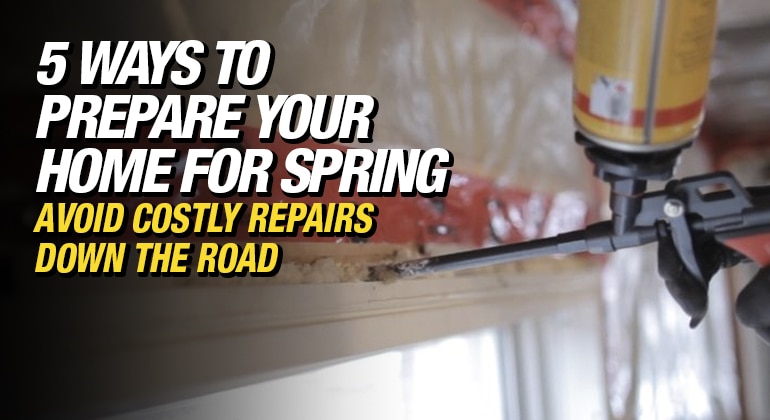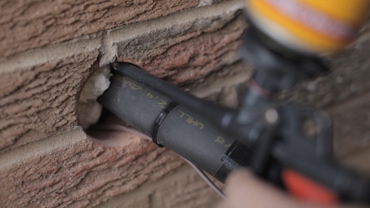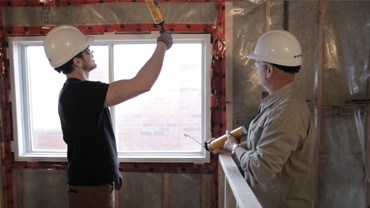When it comes to homes, water is enemy number one, and these 3 exterior home maintenance tasks will help prevent water damage. Water damage is one of the most costly...

5 Ways To Prepare Your Home For Spring
By Mike Holmes
Mike’s Advice / Mike Jr
Thursday, May 3rd, 2018 @ 2:15pm
How To Prepare Your Home for Spring
Spring has arrived and warmer weather is ahead, which means it’s also time to get started on your spring home maintenance. I know, I know, we just made it out of winter – but believe me, this is one job you don’t want to put off. In the spring a lot of people start planning renovations around the home, but I want to remind you to take care of spring maintenance tasks first.
If you take good care of your home and perform necessary maintenance, you can avoid taking on unneeded costly repairs down the road.
Keep in mind, if you have any work that requires an expert, the sooner you can bring someone in, the better, as contractors’ schedules tend to fill up fast once spring arrives.
Here is what should be on your spring maintenance checklist:
- Seal any cracks and broken weatherstripping
- Check your foundation for cracks
- Inspect your bricks
- Inspect your roof and start looking into a roofing contractor before fall if needed
- Do a deck inspection yourself to make sure your deck is safe to use
#1 Seal Cracks
You may not know when it’s time to bring in a pro, so I want to talk about a few simple things you can do to check that your home is ready for the spring season. People often ask me what products I would recommend to perform seasonal home maintenance. I have been using Sika products on the construction site and in my home, they have an extensive line of products for various jobs like repairing cracks and weather sealing doors and windows. Mike Jr. has been using the Sika construction adhesive for some pretty cool projects for our latest show.
As a general rule, you always want to pick products that are multi-purpose, work well both indoors and outdoors and can be used during multiple seasons. Here are some basic checks you want to do around the house:

Prepare Your Home For Spring exterior renovation. Fill Any Holes or Gaps In Your Exterior with Sika® Boom.
#2 Check Your Foundation
Walk around the exterior of your home and look for cracks in your foundation. Mark any cracks that you come across with tape and check them every three months. If the crack doesn’t grow, it can usually be filled with an epoxy injection. I use Sikadur® Crack Fix, which is a low-viscosity, high-strength epoxy resin great for sealing hairline cracks in horizontal concrete.
Some hairline cracks are normal but if you find a foundation crack that is large enough to fit a coin in, it’s time to call a professional – do not attempt to fix it yourself, you could do more damage than good.
If your basement is unfinished, make sure you repeat this process indoors.
How to seal cracks in the foundation in your basement?
If your foundation has serious cracking, you will want to excavate the foundation to expose the crack from the outside. Cracks will then be filled with hydraulic cement that will expand as it dries, creating a seal. This is when you will need to bring in professional basement water proofers.
#3 Inspect Your Bricks
The mortar between exterior bricking needs regular maintenance. If you notice that it’s crumbling, this can cause problems like loose bricks, or cause water to penetrate the wall, damaging the structure behind the bricks. The process to fix crumbling mortar is called tuckpointing, which involves scraping out the old mortar and replacing it with new. The new mortar should seal any gaps between the bricks to keep everything in place.
For small mortar jobs on brick walls, I use Sikaflex® Mortar Fix, a high performance, polyurethane-based joint sealant that is great for repairing brick and concrete wall. It’s durable, elastic, and non-sagging material that has an excellent resistance to aging and weathering.
Tuckpointing can be a labour-intensive job. If you don’t repair it in time, the brick can deteriorate, causing damage to the exterior wall. In some cases, you may have to tear down the wall and rebuild – and that’s going to cost you. When in doubt always contact an expert masonry.
#4 Inspect Your Roof
Winter weather can wreak havoc on your roof. Do a visual inspection of your roof to look for signs of wear and tear. Peeling or missing shingles are a sign that it may be time to replace your roof.
While you’re inspecting your roof, have a look at your eavestroughs. They might be clogged with debris left from the winter, compromising their ability to remove excess water from your home. You want to be sure that your gutters are clear, so rainwater can easily pass through and away from your foundation.

While you’re inspecting your roof, have a look at your eavestroughs
#5 Seal Windows, Doors and Gaps
Most homeowners don’t realize that the average home can lose up to 30% of its heat due to drafts from damaged or missing caulking, which is why it’s so important to do a thorough check of your windows, doors, and other areas (like around exhaust areas).
Inspect all weatherstripping and caulking around windows and doors. If you find sections that are missing or damaged, replace them as necessary. Also check for any gaps or small cracks where drafts, insects or small pests can enter the home. I use SikaBoom®, a low-expansion, polyurethane foam to weather seal and insulate windows and doors. I like it because it prevents bowing and warping of window frames and doors and can even be used as a pest blocker.
For more information on Sika products – https://can.sika.com/
Most homeowners don’t realize that the average home can lose up to 30% of its heat due to drafts from damaged or missing caulking, which is why it’s so important to do a thorough check of your windows, doors, and other areas (like around exhaust areas).
#6 Do a Deck Inspection
Your deck’s structural components are exposed to the weather. Over time it may become compromised. That’s why it is so important to make sure your deck is safe to use, and that starts with a deck inspection. These are a few things you should be looking out for:
- Ledger board issues
- Rotting deck boards
- Rotting deck posts and beams
- Insect Damage on A Deck
Here is a full guide on how to inspect your deck yourself.
Spring is a great time to get outside and make sure your home is in good condition after we’ve been shut indoors all winter long. The good news is, once you’ve taken care of your spring maintenance – there’s nothing stopping you from getting outside, kicking your feet up and enjoying the warmer weather. If you’re planning a renovation this spring, make sure you do your research before hiring a contractor.
READ NEXT:








